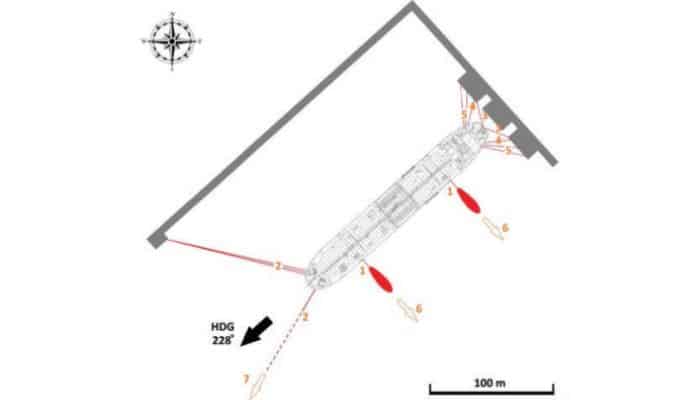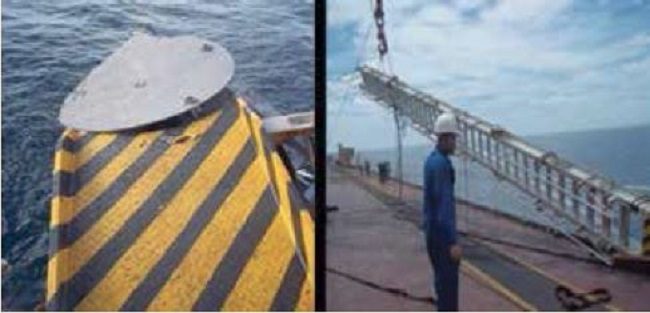Real Life Incident: Stern Line Failure While Departing Causes Fatality
A tanker in ballast was departing berth under pilotage with the assistance of two tugs on the port side.
The vessel was berthed ‘Mediterranean style,’ with lines running astern to the pier and to starboard on another pier in combination with an anchor on the port side, as shown in the diagram

The Master and the pilot agreed on the unberthing sequence as follows:
1. Both tug boats to be secured port side fore/aft.
2. The three mooring lines from the starboard side forecastle deck to be released and the anchor to be engaged.
3. The two mooring lines not under tension at the aft bitts to be released from the pier and collected through the stern centre chock.
4. The two aftermost ropes to be released and collected on their drums.
5. The four remaining ropes aft (two starboard and two port) to be released and collected on their drums.
6. Both tug boats to pull the vessel sideways to clear her from the pier.
7. Heave up the anchor
When the three lines forward on the starboard side were released and brought on board (step 2 in the plan), the vessel began to yaw to port due to a light breeze on the starboard bow. This may have caused some consternation on the bridge. Having no view of the afterdeck, the Master asked about the distance of the vessel’s stern from the berth. The officer replied it was about seven metres.
The Master then requested the Officer astern to engage all six remaining lines (three from each side) and bring them on board. Meanwhile, the two tugboats on the port side were already beginning to pull the vessel to port. With so many lines aft to bring in at once, the operation was not easy at the aft mooring station. One line to starboard remained taut as the others were being brought aboard.
Before the tension could be released, the line parted and whiplashed on deck. The end of the broken line hit a crewmember on the back and he collapsed. Despite resuscitation efforts both onboard and later on shore, the victim succumbed to his injuries.
The official investigation found, among other things, that the stern line had probably failed at a tension that was less than the indicated amount on the Test Certificate, even though it was in good condition. Upon further investigation the Test Certificate was found to be non-authentic.
Lessons learned
- Good plans can quickly fall to pieces if there is miscommunication or a change in planned sequence. In this case the aft mooring team was overwhelmed, as steps 4 and 5 of the original plan were combined into a single operation, and the tugboats started to pull too early.
- Acute situational awareness around lines under tension is a critical attribute to avoid bad consequences at mooring stations. Crew should be aware of snapback risks and have training on how to predict snapback areas depending on where a line may fail.
- Non-authentic documentation is not easy to spot. Efforts should be made to use credible suppliers and transparent supply chains
Reference: The Nautical Institute
Do you have info to share with us ? Suggest a correction
About Author
Marine Insight News Network is a premier source for up-to-date, comprehensive, and insightful coverage of the maritime industry. Dedicated to offering the latest news, trends, and analyses in shipping, marine technology, regulations, and global maritime affairs, Marine Insight News Network prides itself on delivering accurate, engaging, and relevant information.

About Author
Marine Insight News Network is a premier source for up-to-date, comprehensive, and insightful coverage of the maritime industry. Dedicated to offering the latest news, trends, and analyses in shipping, marine technology, regulations, and global maritime affairs, Marine Insight News Network prides itself on delivering accurate, engaging, and relevant information.
- Real Life Incident: Vessel Collision in Good Visibility
- Real Life Incident: Severe Injury To Deck Crew While Leaving Berth
- Real Life Incident: Departure Damage in Very Restricted Waterway
- Real Life Incident: Low Situational Awareness Has High Impact Consequence
- Real Life Incident: Fouled Anchor in a Designated Anchorage
- Real Life Incident: Fire On Barge Carrying Scrap Metal Causes $7 Million Worth Of Damage
Latest Case studies Articles You Would Like:
Subscribe To Our Newsletters
By subscribing, you agree to our Privacy Policy and may receive occasional deal communications; you can unsubscribe anytime.















